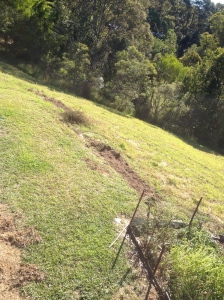 Beginnings – first new-cut beds and the edge of the established veggie garden.
Beginnings – first new-cut beds and the edge of the established veggie garden.
It’s been a busy first ten days, unpacking boxes and getting to know the house and the neighbourhood. In among all the essential first things like seeing to the floors, deck and railings, which were a bit weathered, I’ve dug a few new beds. As you can see from the photo, the land around the house is mainly pasture, with an established veggie garden right in front of the house. The established patch, with its two extra levels of cardboard and plastic -covered beds, was a gift, perfect for getting some seeds in quickly, but the patch will move in time to areas that better fit our plans. The frequent visit ‘kitchen garden’ will be in the area beyond the left of the photo. The current far bed is the pawpaw patch(seeds still to germinate), which would be a nice transition between the subtropical herbs and the veggie patch. The closer new-cut bed is sown with nasturtiums and borage, and now has above it a bed of salvias under-sown with nemesias.
I’ve found that a 2.5 m x 1 m bed is a good size for hoeing, forking, digging and prepping in a session, meaning that I can do two in a day if there aren’t other things to take up the hours. So I’ll see how I go with that sort of progress. Already things are starting to fall into place, where just a sea of grass was daunting a week ago. The turf lifts fairly easily, and the soil is good. I think a geologist would call it a dermosol, the alternative to the strikingly red krasnozem ferrosols we also get here. That means it will be very acidic but with great structure and potential fertility, so I’m treating all my new beds with lime and dolomite lime to get those divalent cations (and pH) up. Ive never gardened with this kind of soil before – it has amazing texture, forming strong crumbs but draining freely and yet holding moisture well, even in direct sun.
We have had a warm and dryish late autumn, which is a bonus for the seedlings. All the brassica -type seedlings were up very quickly (you can tell them by their paired heart-shaped cotyledons); they are largely winter veggies and range from root crops like turnips to leaf and flower crops like wom bok and broccoletti. The carrots, beetroot, and lettuces followed a little later, then the peas, and now I am waiting for the onions to sprout. I will post on each (there are around 40 sown varieties so far) as and if they do something interesting, like grow enough to eat.
Now I’m hoping that some of the forecast rain falls here. A splash would be great.
